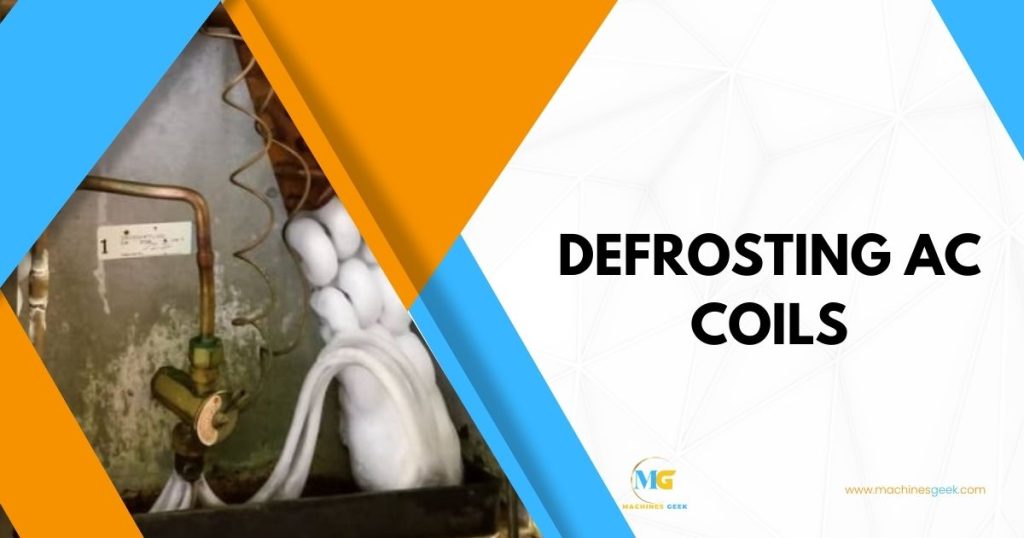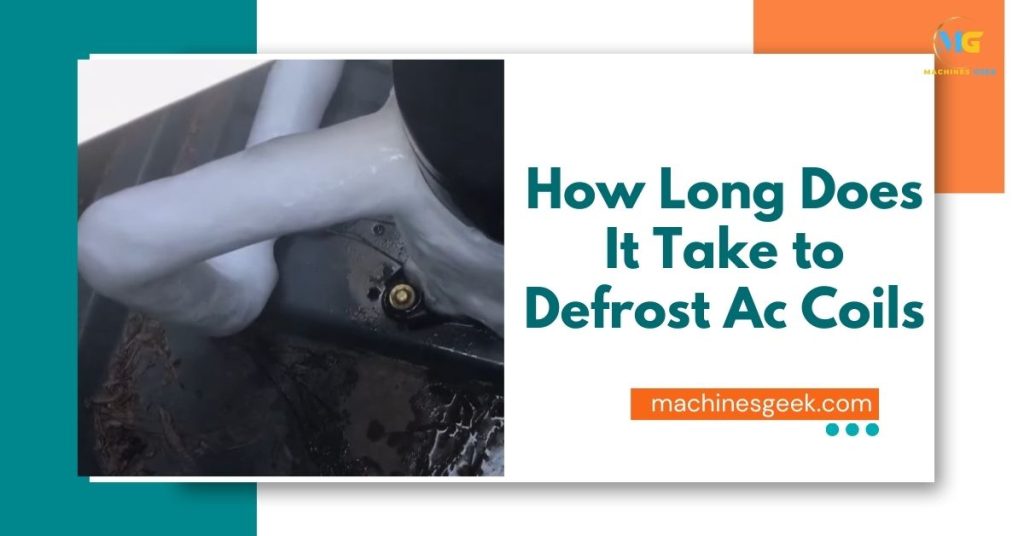How Long Does It Take to Defrost Ac Coils? It takes approximately 4-6 hours to defrost AC coils. AC coils typically take 4-6 hours to defrost, depending on the size and extent of ice buildup.
Properly defrosting AC coils is essential to ensure efficient cooling and prevent damage to the system. This article will explore the causes of frozen AC coils, signs of ice buildup, and methods for defrosting. We will also provide useful tips to prevent future coil freezing.
Understanding the defrosting process and taking preventive measures can help you maintain optimal AC performance, prolong the lifespan of your system, and save on energy costs. So, let’s dive into the details to better understand how to defrost AC coils.
The Importance Of Defrosting Ac Coils
AC coils accumulate frost and ice due to various factors, including humidity levels and airflow restrictions. This build-up can have negative effects on the performance and efficiency of your air conditioning system.
When frost and ice form on the AC coils, they create an insulating barrier that hampers the heat transfer process. This means that your AC unit has to work harder and longer to cool your space, leading to increased energy consumption and higher utility bills.
Moreover, the accumulation of frost and ice can cause the AC coils to freeze, resulting in restricted airflow and reduced cooling capacity. This not only decreases the comfort in your environment but also puts additional strain on the compressor, potentially leading to system malfunctions.
Regularly defrosting the AC coils is crucial to prevent these issues. This can be done manually or through an automatic defrost cycle, depending on the type of air conditioning system you have. By keeping the coils free from frost and ice, you can optimize the efficiency and performance of your AC unit, ensuring a comfortable indoor environment while minimizing energy consumption and potential breakdowns.
Factors Affecting Defrosting Time For Ac Coils
Factors such as environmental temperature, humidity levels, and the size and condition of the AC unit and coils can affect the time it takes to defrost AC coils.
The role of environmental temperature in defrosting time
Higher temperatures typically lead to quicker defrosting of AC coils. When the outdoor temperature is warmer, the ice on the coils will melt faster, reducing the time it takes to defrost.
The impact of humidity levels on the defrosting process
Higher humidity levels can make the defrosting process slower. When the air is more humid, the ice on the coils will have more moisture, making it harder to remove.
The size and condition of the AC unit and coils
The size of the AC unit and the condition of the coils can also impact defrosting time. Larger AC units with more coils may take longer to defrost compared to smaller units. Additionally, if the coils are dirty or damaged, it can hinder the defrosting process.
It’s important to consider these factors when defrosting AC coils to ensure efficient and effective performance of the air conditioning system.
Time Required For Defrosting Ac Coils
Defrosting AC coils is an essential maintenance task that helps ensure the efficient functioning of your air conditioning unit. The time required for defrosting depends on various factors, including the severity of the frost buildup and the size of the coils.
On average, the defrosting process can take anywhere from 1 to 3 hours. However, it’s important to note that this estimate may vary based on individual situations. For instance, if the frost accumulation is minimal, it might take less time to complete the defrosting process.
Regular maintenance plays a crucial role in minimizing the time required for defrosting AC coils. By keeping your unit clean and well-maintained, you can prevent excessive frost buildup and ensure a faster defrosting process. Additionally, it’s recommended to schedule regular maintenance inspections with a professional HVAC technician to identify any potential issues that may impact the defrosting time.
In conclusion, the time required for defrosting AC coils depends on factors such as frost buildup severity and coil size. By performing regular maintenance and addressing any issues promptly, you can reduce the time needed for defrosting, ensuring efficient performance of your air conditioning unit.
Common Methods For Defrosting Ac Coils

Defrosting AC coils is an essential maintenance task that ensures the optimal performance of your air conditioning system. There are several common methods for defrosting AC coils, including manual defrosting techniques and automatic defrosting systems.
Manual defrosting techniques involve using warm water to melt ice on the coils. This method is effective but requires caution to prevent water damage to the AC unit. Another option is utilizing hairdryers for faster defrosting. The warm air from the hairdryer helps melt the ice, making it easier to remove.
Scraping off ice with a soft brush is also commonly used. It is important to be gentle to avoid damaging the delicate coil fins. On the other hand, automatic defrosting systems are equipped with advanced technology that detects frost buildup and initiates the defrosting process automatically.
Automatic defrosting systems are a convenient option as they require minimal manual intervention. However, it is important to consider their limitations and ensure proper maintenance to prevent any malfunctions.
Tips For Efficiently Defrosting Ac Coils
Proper insulation and sealing of the AC system can help prevent ice buildup on the coils. This ensures that cold air is properly directed to the desired areas and reduces the chances of coils getting frozen.
Regular cleaning and maintenance of the AC unit is crucial for efficient defrosting. This includes cleaning or replacing air filters, inspecting the coils for debris or dirt, and clearing any obstructions that may hinder airflow.
Optimizing airflow around the coils also aids in defrosting. This can be done by keeping the surrounding area clear of objects that may obstruct airflow and ensuring vents and registers are open and unblocked.
Troubleshooting common defrosting issues involves checking the thermostat settings, ensuring the defrost cycle is functioning properly, and inspecting the fan motor for any issues that may affect airflow.
Identifying potential causes of slow defrosting may include checking the refrigerant levels, inspecting the condenser coils for damage, and ensuring the outdoor unit is free from ice or snow buildup.
If defrosting takes longer than usual, steps to take may include manually defrosting the coils using warm air, checking for any blockages in the drainage system, and contacting a professional technician if the issue persists.
Is a Reset Issue Related to Frozen AC Coils?
A frozen AC coil can often be linked to an air conditioner plug reset issue. When the system is overloaded, the plug may trip, causing the coils to freeze. Checking the plug and resetting it if needed can help resolve the problem and restore proper functionality to the AC unit.
Frequently Asked Questions
How Long Does It Take To Defrost Ac Coils?
Defrosting AC coils usually takes about 4-6 hours, depending on the severity of the ice buildup.
What Causes Ac Coils To Freeze?
AC coils freeze due to restricted airflow, low refrigerant levels, dirty coils, or faulty thermostats. Regular maintenance helps prevent this issue.
How Can I Defrost Ac Coils Faster?
To defrost AC coils faster, turn off the unit, switch on the fan-only mode, and wait for the ice to melt. Using a hairdryer can also speed up the process if done carefully.
Conclusion
To wrap it up, defrosting AC coils is essential for efficient cooling performance and preventing damage to your air conditioning system.
The defrosting time can vary depending on factors like weather conditions and the extent of ice buildup. Regular maintenance and cleaning can help reduce the frequency of ice formation and ensure optimal functioning.
By following the right steps and seeking professional help if needed, you can keep your AC coils ice-free and enjoy a comfortable indoor environment all year round.








